HDPE Geomembranes Exhumed from Environmental Facilities Evaluated by Mass Spectrometry
Leonardo Antonio Valentin1*, Fernando Luiz Lavoie1,2, Clever Aparecido Valentin1, Marcelo Kobelnik1, Maria de Lurdes Lopes3 and Jefferson Lins da Silva1*
1São Carlos School of Engineering - EESC, University of São Paulo - USP, Brazil
2Department of Civil Engineering, Mauá Institute of Technology, Brazil
3Department of Civil Engineering, University of Porto, Portugal
Submission: August 18, 2023; Published: September 07, 2023
*Corresponding author: Leonardo Antonio Valentin, São Carlos School of Engineering - EESC, University of São Paulo - USP, São Carlos, SP, Brazil, Email ID: leonardo_valentin@hotmail.com
Jefferson Lins da Silva, São Carlos School of Engineering - EESC, University of São Paulo - USP, São Carlos, SP, Brazil, Email ID: jefferson@sc.usp.br
How to cite this article: Leonardo Antonio V, Fernando Luiz L, Clever A V, Marcelo K, Maria d L L. HDPE Geomembranes Exhumed from Environmental Facilities Evaluated by Mass Spectrometry. Int J Environ Sci Nat Res. 2023; 32(4): 556345. DOI 10.19080/IJESNR.2023.32.556345
Abstract
A geomembrane is a material of the geosynthetics group used as a liner in various applications including environmental protection systems. Two High Density Polyethylene (HDPE) geomembranes exhumed used in different applications including the exposure of various types of contaminants in different period of time were evaluated. The Gas Chromatography coupled with Mass Spectrometry (GC-MS) technique was applied to determine and identify the Organic Compounds using their masses (m/z) and spectra (fragmentation) for characterization of materials and compare with other 5 groups from a previous study and multivariate analysis were applied. Moreover, 347 groups of compounds were considered and 154 met with interpretation, p-value criterion < 0.05 and cut-off criterion of 2.0 for the fold change analysis and then considered. Results were obtained for common compounds for all samples (markers) and specific compounds for each exhumed sample. The combination of GC-MS analysis with multivariate was applied and shown to be an interesting tool for this characterization. The differentiation related to the five groups and the two exhumed samples can be observed. The marker compounds can also be compared with other groups, classification models can be proposed and also contribute to future studies for different geomembranes in different applications.
Keywords: Geomembranes; Mass spectrometry; Multivariate; HDPE; Environmental; Sewage; Landfill leachate
Introduction
A geomembrane is a kind of product of the geosynthetics family used, among other applications, as a barrier in the environmental systems. The geomembranes began to be used in the 1930s but emerged in the 1940s. In the 1970s, the geomembranes began to be used for landfills in general. This of polymeric product is manufactured by the industry using different types of polymers and, in the field, is installed in different types of applications [1].
Depending on the resin used, various types of geomembranes are available. Among the most used geomembranes we can highlight: Ethylene Propylene Diene Monomer (EPDM), High-Density Polyethylene (HDPE), Linear Low- Density Polyethylene (LLDPE), Reinforced Polypropylene (RPP), Polyvinyl Chloride (PVC), Reinforced Polyethylene (TRP). HDPE geomembrane is the main and the most used geomembrane in the world, mainly for landfills and wastewater ponds. The reasons for the great use of this material are, among others, the high chemical and mechanical resistance combined with a low permeability coefficient and low production cost [1-7].
Historically HDPE geomembranes began to be used in Europe, South Africa and then transferred to North America. In the beginning, they were used in channels, and their applications spread to Canada, Russia and Europe. In the early 1980s, HDPE became famous for their chemical resistance and for being heat welded. The application of HDPE in municipal landfills and in hazardous waste has advanced from 1985, due, mainly, to the high strength and cost. Currently, HDPE is the most used component of liner solutions worldwide [8-12]. Although quite subjective, the current application areas of geomembranes can be observed in three main categories: transport, environmental and geotechnical. Each of these categories has a significant number of applications that have been published in the literature [8]. The geomembranes are applied in many kinds of situations and different kinds of construction works and are shown in Figure 1.
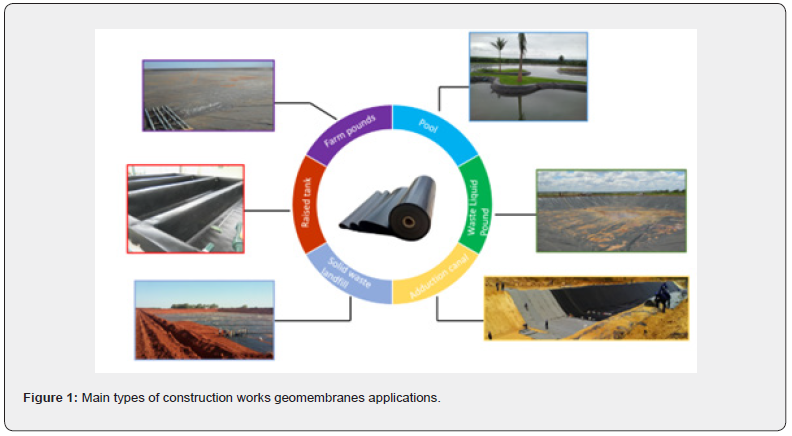
The geomembranes are exposed to different process, including thermal degradation, UV degradation, swelling, oxidative degradation, extraction degradation and biological. These processes influence significantly the material’s properties and even decrease its durability [13,14].
In terms of manufacturing, HDPE are formulated between 96- 97.5% polyethylene, 2-3% UV protection, usually carbon black, and 0.5-1.0% antioxidants and thermostabilizers [15-19]. This kind of product, when exposed to aging, may undergo property changes due to molecular factors like chain scission, bond breaking and cross-linking [15,20].
Regarding the polyethylene polymer (PE), the main component of manufacturing, it can be defined as a polyolefin that has a hydrocarbon group formed of carbon and hydrogen in its structure. When the co-monomer increases, we observe that the density of PE decreases and the density of the material influences their properties (physical and mechanical). Regarding HDPE, it is a polymer with a semi-crystalline structure that is susceptible to stress cracking. The composition of HDPE is composed of MDPE resin added with carbon black and some additives, which makes its density greater than 0.940g mL-1 [11,21-23].
Although it was observed several studies in the literature with different types of exhumed geomembranes used in different types of applications [24-30], and in no case was the identification or attempted to identify the compounds formed or adhered after contact with contaminants from different applications of the material was explored.
In research from the authors [7], two exhumed HDPE geomembranes exposed to different conditions were evaluated using techniques such as thermoanalytical, physical, and mechanical analysis. In this research it was realized that, in the vast majority of studies, there are no investigations on the chemical alteration of these materials in order to identify the compounds. This is undoubtedly a major challenge, as prior information on materials is generally extremely limited.
Recently our group published an article on the chemical characterization of the five main geomembrane manufacturers in Brazil [31]. This information is extremely valuable for proposing markers and differentiating between exhumed samples.
Thus, the objective of this work is analyzed and differentiate two HDPE samples exhumed in different applications and exposure [7] aiming at the identification of chemical compounds formed from the differentiation of the proposed marker compounds comparing with results between groups of virgin samples already studied [31]. For this, gas chromatography coupled to mass spectrometry and multivariate statistical tools will be used.
Material and Methods
Material
For this study, in addition to the results obtained in the previous work, two different samples of exhumed HDPE were used, both collected from sanitation works. Sample 1 was exhumed after 2 years and 9 months of operation from a sewage treatment aeration pond (LTE). The reason for replacing this membrane was the damage caused during the operation. Sample 2 from a municipal landfill leachate pond, was exhumed (LCH). In this case, this membrane was used for about 5 years and 2 months and the exhumation occurred due to the need to expand this landfill. Table 1 presents the main properties for LTE and LCH obtained in our previous study according to ASTM standards [38-43]. Sample 1 is a 1.0mm nominal HDPE and is shown in Figure 2A. Sample 2 shows the landfill leaching pond that had a 2.0mm thick HDPE Figure 2B For determination of compounds, vials with screw caps of 22mL and 2mL from Agilent were used and the solvent was Dichloromethane (DCM) purchased from JT Baker. Both works are located in Brazil.
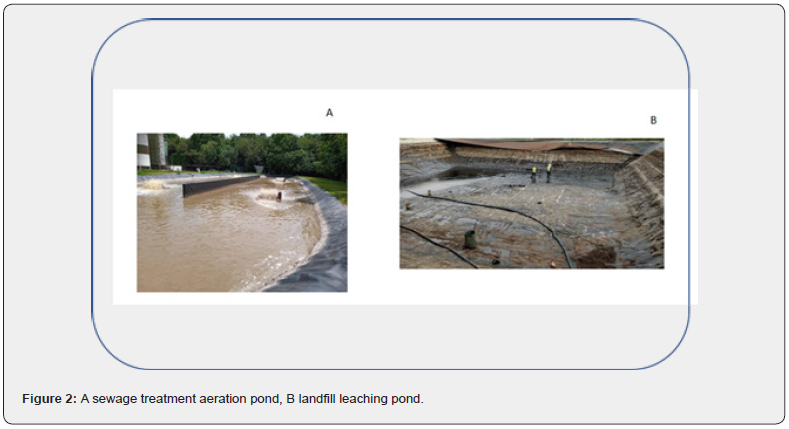
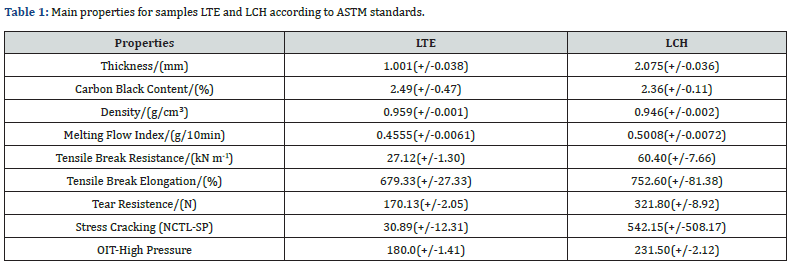
Methods
The determination of compounds was conducted in two stages. In the first the samples were extracted with DCM with heating and ultrasonics. Then, in the second phase, all samples were determined in a GC-MS for the organic semi-volatile compounds.
Parameters for Determination of Organic Compounds by GC-MS
The compounds were determined according to [31]. The sample preparation was conducted as follows: 2g of samples were weighted and then transferred to vials of 22ml, filled with 10ml of DCM and finally sealed. The samples were sonicated for 10 minutes at 60°C. 1mL was added to vial and taken to the CTC Comb Pal Sampler (CTC Analytics). The injection was performed using liquid injection configuration by GC-MS (7890B Agilent). The equipment was configured with S/SL inlet with single quadrupole MS 5977A in scan mode. The complete sample preparation and determination workflow can be seen in Figure 3. Table 2 lists the instrument parameters used during the study.
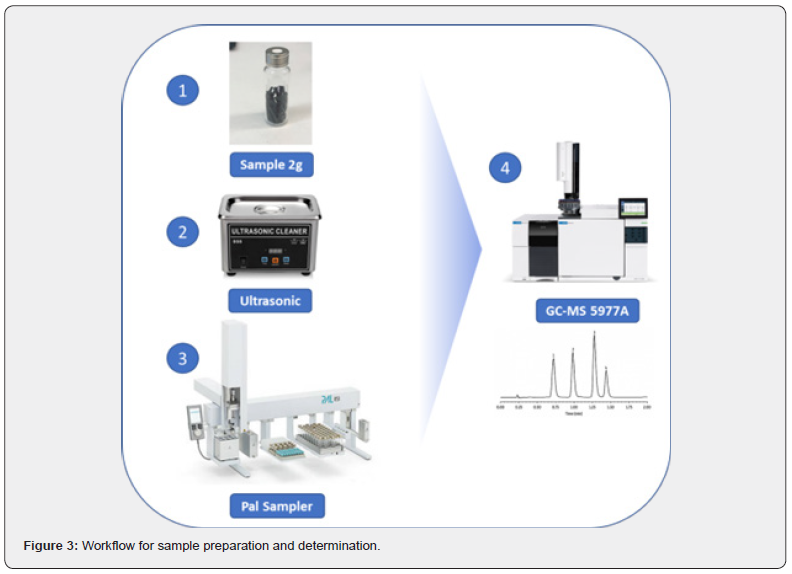
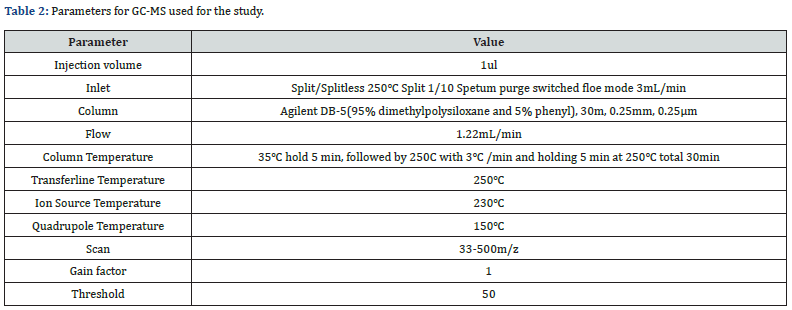
The qualitative analysis of the results was carried out by “Mass Hunter Qualitative” version B.10.00 by deconvolution process. The compounds were processed using Agile 2 integrator and identified using NIST library (ID Browser). The criteria for identification were defined with score of 80% at least using NIST library. All analyses were performed in triplicate including DCM to evaluate the repeatability and robustness of the method.
Statistical Analysis
All identified compounds were processed in MassProfinder software version 10 (Agilent) to evaluate the false positive and to check the spectral fidelity and still the confirmation of the fragments. In Profinder, there are some algorithms specific where can find and then confirm the identity. The algorithm chosen for this study was Batch Recursive Feature Extraction (BRFE) that is derived from Molecular Feature Extraction (MFE). MFE is an untargeted or “naïve” feature finding algorithm. It performs extraction quickly and no specific prior knowledge of the ions to be extracted is required. In contrast, BRFE with Find by Ion FBIon is a targeted feature extraction algorithm only if searches for a specific list of ions provided by rMFE. FBIon reduces the number of false negatives and false positives.
Then, the tolerance percentage was defined by identification, integrator, spectrum extraction and finally post-processing parameters. The Profinder compares all samples and blanks to identify the false positives compounds. All the steps used for Batch Recursive Feature Extraction can be found in Figure 4. In each of the steps shown below, is possible to choose the best way or the desired way to extract the compounds. The parameters range from the chromatographic peak integrator to the mode of extracting the mass spectrum or the height-based filter.
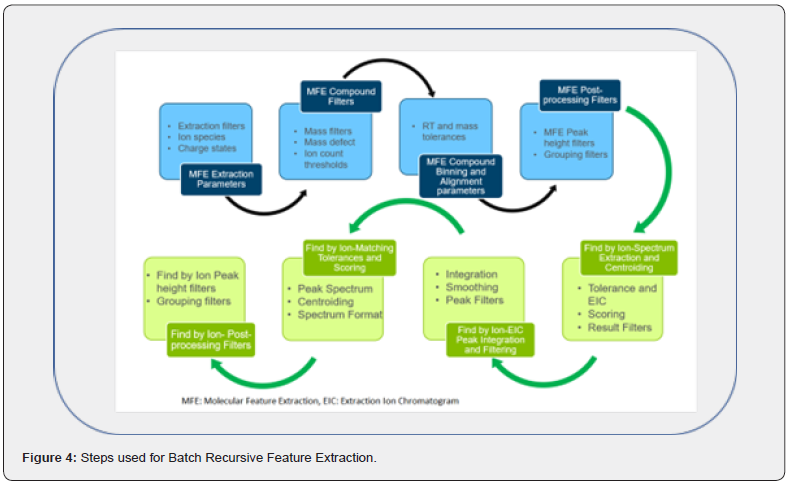
In the final step, the data were exported to Common Event Format (.cef) and then to Mass Profiler Professional (MPP) version 15.1 (Agilent) and the statistical were applied. With the MPP was possible that all samples were grouped (different groups) and analyzed with multivariate tools. For the multivariate evaluation, in the first step, the significance analysis was performed checking if the groups rejected the null hypothesis or not considering p < 0.05. The Principal Component Analysis (PCA) was selected as an auxiliar method to find the variables and then separate the groups (geomembranes) according to the clusters. The Fold Change algorithm was applied as a measure to assess the variation between the first group and the other groups considering the ratio between the two measures and the variation of unfolding for groups.
With all this, a new interpretation was created with the five virgin samples from the previous work [32] and applied within the MPP software to analyze with the Find Unique Entities tool. After finding the markers a new interpretation was created but now with only the two HDPE samples exhumed. From there, the two interpretations were compared and the compounds for the two exhumed samples proposed. Figure 5 shows, through a didactic design, the workflow applied to the choice of marker compounds and the proposal of the compounds formed or aggregated in the exhumed samples. In step 1 and 2, each doll with different colors represents a compound belonging to each group. Step 3 the softwares profinder and MPP for statistical analysis were applied to find similarities between all groups. In step 4 compounds were generated which were present in all groups. Then the groups are compared (step 5) and finally generated the unique compounds in the exhumed samples (step 6).
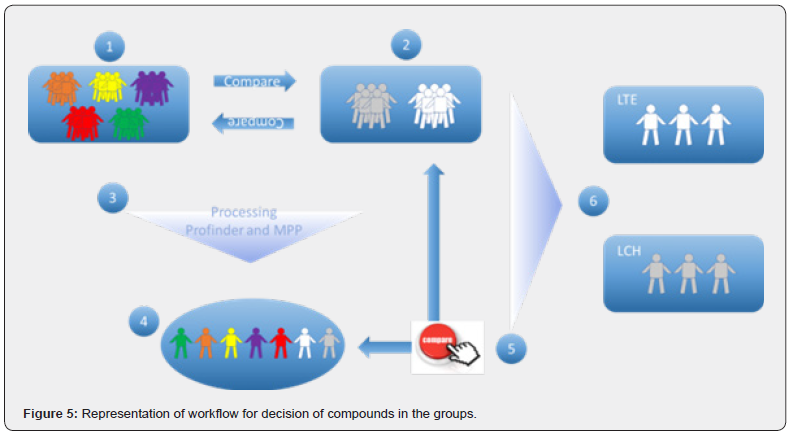
Results
The results obtained for the group of five samples and for the two exhumed samples were initially evaluated using the Massprofinder software. In this step, 347 groups of compounds were obtained by applying the criteria described in the steps shown in Figure 6. Among the parameters it can be highlighted the minimum count of 500 counts in the initial step of Extraction Parameters. A second step that can be highlighted is the Spectrum Extraction and Centroiding where the Average of spectra at peak start and end option was applied. In these two chosen parameters some compounds with a low abundance and which did not have consistent spectra were avoided. For the extraction, working with the average, possible coelutions can be evaluated and easily make the decision between the groups that will be considered. Then, the responses between triplicates, integration, spectral fidelity and absence of compounds in the blank were evaluated. With these criteria, 154 groups of compounds were considered, and these were taken for statistical evaluation.
In the statistical criteria the value of p<0.05 and a cut-off 2.0 for fold change was considered. Thus, the significance analysis was applied and the compounds that met the criteria were used. In the next step, the selected compounds were processed and considered on the 3D graph with the PCA values. In the PCA graph it can observe a good separation between the groups which showed a great indication about the initial proposal of this work. In Figure 6 is possible to find the result of PCA analysis with 3D graphics.
With the statistical evaluation applied, a list was proposed and generated with the markers for the seven groups of compounds (five virgin geomembranes and two exhumed). Then by comparing the marker compounds and the exhumed samples differentiation of the exhumed samples from the others is achieved. As a last step, it was possible to differentiate the two exhumed samples by comparing them and evaluating the behavior on the exposure of these materials to different conditions.
Discussion
Seven samples (5 virgin and 2 exhumed) were determined and evaluated in this study. The objective number one was identifying the candidate compounds for markers among all samples using the GC-MS technique and multivariate statistical. The five virgin samples were chosen from a previous study [31] where excellent results in the chemical characterization and differentiation of these materials were obtained. In this previous study, five samples from the main geomembrane manufacturers in Brazil were evaluated and chemical characterization was performed using the GC-MS technique [31]. The two exhumed samples were also obtained from a study by our group [7] where was realized the importance of identifying these compounds that occurred by exposing the material to different conditions and exposure time. The first satisfactory result of this work was to obtain the marker compounds by comparing the groups with the statistical tools. The second important aspect was the application of the statistical tool but, at this time, to obtain the compounds possibly adhered to or generated by the material by degradation (exhumed samples) considering the exposure to leachate and sewage for a prolonged period. The main software tool used for the initial evaluation of the groups of compounds was the massprofinder and an overview of this software can be seen in Figure 7. In the left part of this figure the overlap between the groups of samples compared to the blank (DCM) and on the right, the spectrum generated for each of the groups, enabling the evaluation and confirmation of the identity of these compounds.
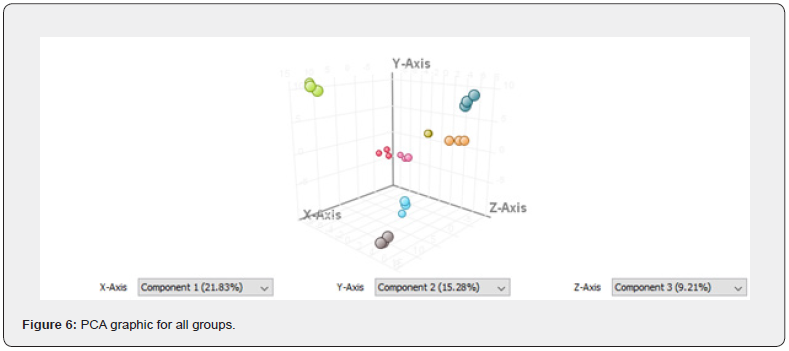
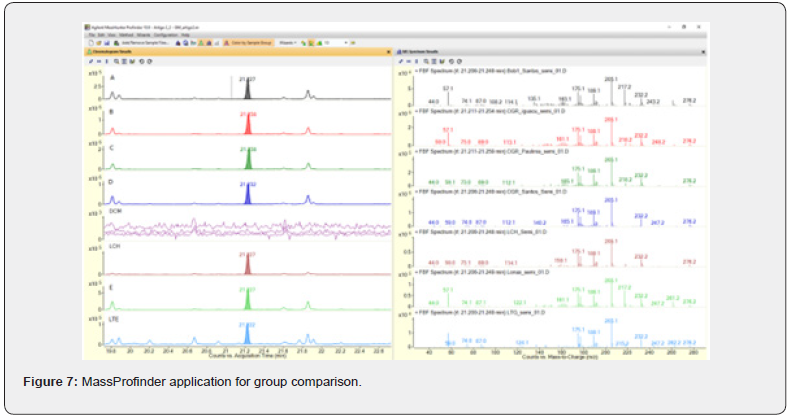
With the massprofinder, first the parameters for the processing were applied from the sequence shown in Figure 4. For each group from A to E and LCH and LTE, the signal to noise, repeatability, peak symmetry, spectrum (fidelity), fragmentation, absence of the compounds in the blank and finally the comparison with the NIST library were evaluated. After all these criteria the compounds were considered or discarded for this study. Then the groups of compounds were saved in. cef format and taken to the MPP statistical software. In MPP, the previously mentioned criteria for p-value and fold change were applied and the significance analysis was performed. Graphs were generated with the application and results of PCA and then the groups were compared. To compare the groups, the five virgin samples were selected first. From the five samples we obtained a table with the specific compounds for each group and the common compounds for all samples. Then the same criteria were applied to the LCH and LTE samples and confirmed the presence of marker compounds. The next step was then to evaluate the unique compounds for the LCH and LTE samples and finally the comparison between LCH and LTE. Figure 8 shows the groups formed in this evaluation generated by the MPP software and then, in Table 3, the results with the compounds that were observed in all the samples and therefore defined as marker compounds.
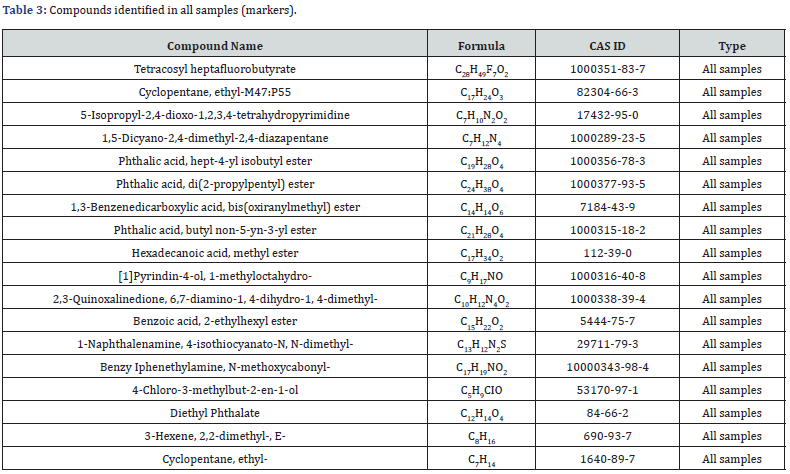
With this comparison, 18 marker compounds, 23 compounds exclusive to LCH, 40 compounds only present in LTE and 49 identified in both (LCH+LTE) were identified. Tables 4 to 6 show the compounds that were identified for LTE sample, LCH sample and for LTE and LCH samples respectively.
Table 3 shows the compounds that are common among the materials and that can serve as a basis for further studies and even compare with new materials that will be studied in the future. At this point, the use of statistical tools applied with the MPP software was fundamental for this proposal. The use of the NIST library provides not only the identification based on the defined criteria but also with complete information about the compounds, such as the Chemical Abstracts Service (CAS) number included in column 3.
The results obtained in Table 4 give us an overview of the compounds found only in the LTE samples. By the number of compounds, it can be highlighted how much time and type of application influenced this characterization [24-30]. It cannot be disregarded the variety of materials that are discarded in sewage pond and consequently the infinity of possibilities of reactions and interactions between materials. Among all the types of materials present in a typical landfill, it can be mentioned residues from agricultural, gardening, hunting management, forestry, fishing (plastic material residues), fruit residues, textile industry, power plants and other combustion, waste from production of ceramics and bricks, packaging, concrete, tiles, earth, metals, asphalt and waste from wastewater treatment, etc. [32]. With this information, it will be possible to continue this study with a detailed evaluation of the samples around the membranes for an even more accurate comparison.
Table 5 shows similar results to those mentioned above for the LTE samples. Significant amounts of compounds identified were obtained only in the LCH samples. As such Landfill Leachate LL can contain high concentrations of metals, ammonia and dissolved organic carbon (DOC), it is also known to contain a wide variety of household waste chemicals such as plasticizers, pesticides, flame retardants, pharmaceuticals and chemicals from personal hygiene [33]. With this composition, it will be also possible, in the future, to perform a specific study to compare the LL composition of the site and the studied geomembrane.
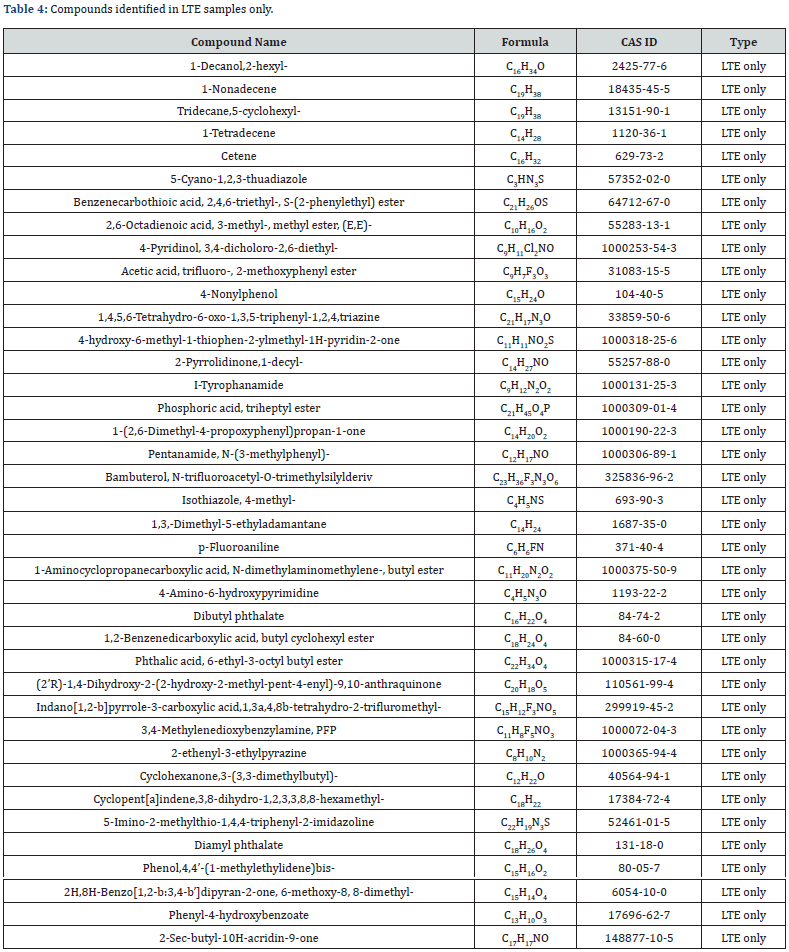
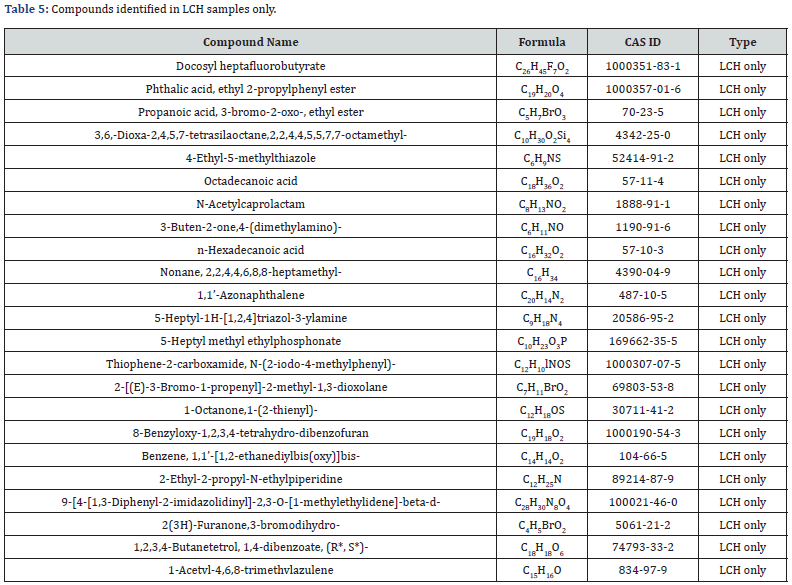
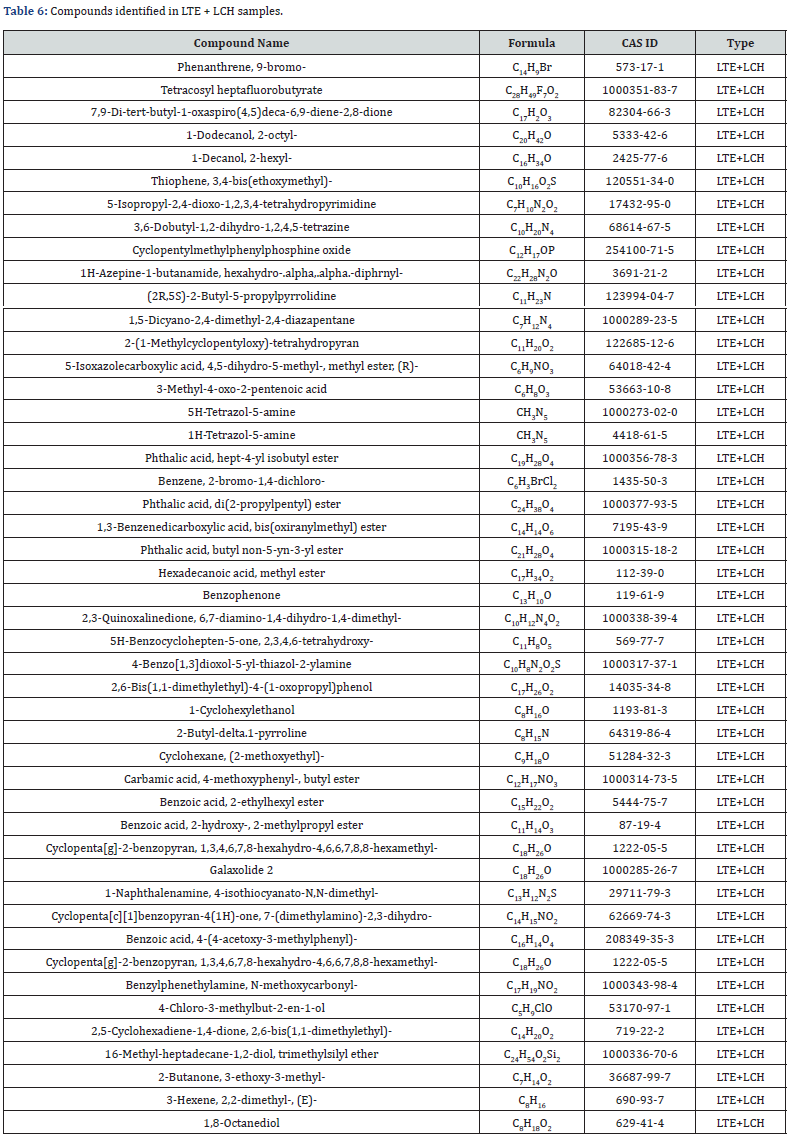
Table 6 shows the composition of the sum of the compounds found exclusively for the two membranes. This result is fundamental in the attempt to propose the compounds possibly resulting from the interaction between these materials and their respective means of exposure. In this way, we realized that it is possible to propose, even without information about the identity of the materials, what were the effects observed in terms of type of exposure and also over time.
For this study, in general, it was also possible to create a workflow that details the steps followed. Figure 9 shows the complete workflow from choosing the material to interpreting the results with the specific tools used in this study. In step 1 the samples identified as A and B are evaluated. Then, in step 2, the determination by GCMS is carried out to separate the compounds and obtain the mass spectra. In steps 3, 4 and 5 the compounds are found and evaluated in terms of presence in all groups and absence in the blank, then compared with statistical tools and finally identified.
For the determinations, the GC-MS instrument was considered a powerful and fundamental tool leading to a good chromatographic separation, a excellent determination of masses (m/z) and confirmatory fragments for the compounds, allows the identification of the compounds by comparison with the NIST library [34,35]. With a simple step of sample preparation by partition with organic solvent, the liquid injection of the extract brought information for the chromatographic profile and this step we can defined as a fingerprint.
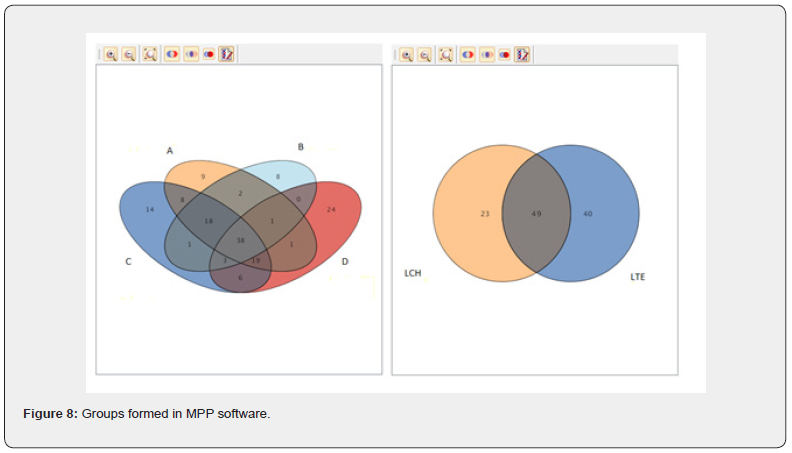
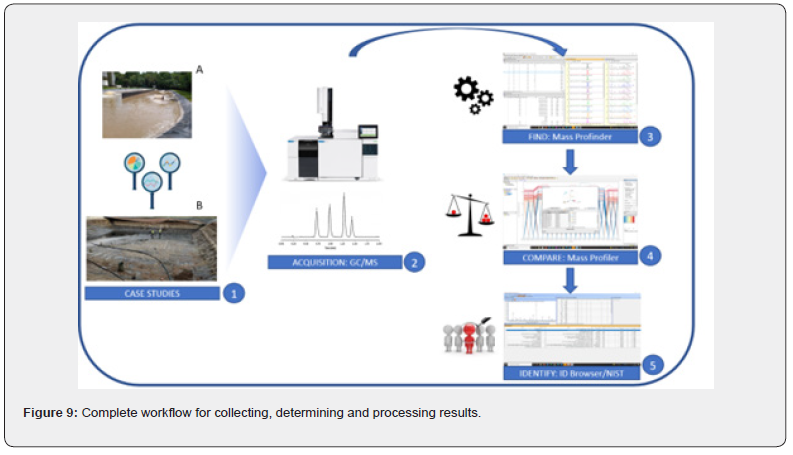
Another important result obtained in this study can be found in Figure 10. This figure shows the results for all groups expressed as the PCA graph in 2D. In this representation it can be seen the results for the LTE and LCH samples very close to two other groups of virgin membranes (sample B light blue and sample D pink). With this result, can be concluded that it is possible to use this representation as a proposal for identification between the groups, which can be used for quality control or even defined as a classification model.
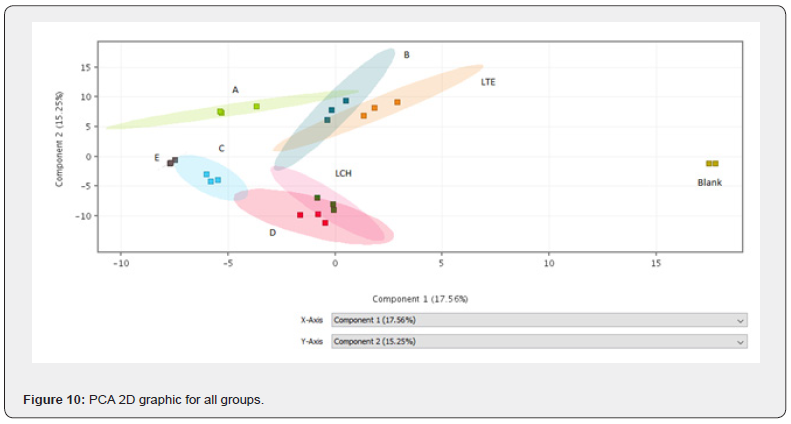
For sample preparation, dichloromethane was used as an organic solvent, which has great extraction power for geomembranes and other materials. In the process as a whole, the combination with heating and ultrasound resulted in an efficient extraction [35].
The use of chromatography with chemometrics presented valuable results and compounds called markers could be determined and selected, unique compounds for the studied samples were proposed and comparisons between groups were performed [36].
Finally, this study showed that is possible to identify, characterize and separate different groups (types or manufacturers or both) and distinct samples from different applications using techniques combined such as GC-MS and statistical analysis. With this study, it was noticed a large universe for further studies, such as the comparison between exhumed samples, soil, water, slurry and other matrices that influence membrane changes in terms of chemical composition and that will serve to complement and enrich the results obtained in this and other studies [37-44].
Conclusion
In this work, the previous results of a study for five commercial geomembranes with different thicknesses were used. Two other samples indicated as LTE and LCH were determined and compared with the previous ones. The GC-MS technique was applied for the chemical characterization of all geomembranes. Compound determinations were carried out and as a result, 347 groups of compounds were selected. Considering the statistical (p-value and fold change), 154 groups of compounds were considered. With initial assessment and application of criteria, compounds were identified using the NIST library and groups separated and compared by PCA analysis.
Thus, the main conclusions of the work were:
a) It is possible to analyze and identify a chemical profile in order to characterize the groups of organic compounds from geomembranes using chromatography coupled with mass spectrometry even with limited information for the origin of the materials.
b) With the combination of chromatographic determination and mass spectrometry and with multivariate analysis, it was obtained excellent combination of chemical characterization for differentiation between the groups studied.
c) It showed the importance of the previous work carried out for the characterization of the five membranes and how much it contributed to the continuation of the study.
d) The previous study with the exhumed samples was also of fundamental importance to understand the need to continue with different evaluations.
The marker compounds can be compared with other groups and still contribute to future studies for different geomembranes in different applications.
References
- Lavoie FL, Valentin CA, Kobelnik M, Lins da Silva J, Lopes MDL (2020) HDPE Geomembranes for Environmental Protection: Two Case Studies. Sustainability 12(20): 8682.
- Rollin AR, Rigo JM (1991) Geomembranes—Identification and Performance Testing. (1st edn), Chapman and Hall: London, UK.
- Palmeira EM (2018) Geossintéticos em Geotecnia e Meio Ambiente. (1st edn), Oficina de Textos: São Paulo, Brazil.
- Koerner RM (2005) Designing with Geosynthetics. (5th edn), Prentice Hall: Upper Saddle River, NJ, USA.
- Scheirs JA (2009) Guide to Polymeric Geomembranes: A Practical Approach. (1st edn) Wiley: London, UK.
- Vertematti JC (2015) Manual Brasileiro de Geossintét(2nd edn), Blücher: São Paulo, Brazil.
- Lavoie FL et al. (2020) Durability of HDPE Geomembranes: An Overview. Química Nova 43(5).
- Rollin AR, Rigo JM (1991) Geomembranes - Identification and Performance Testing. (1st edn), Chapman and Hall: London.
- Eith AW, Koerner GR (1997) Assessment of HDPE geomembrane performance in a municipal waste landfill double liner system after eight years of service. Geotextiles and Geomembranes 15(4-6): 277-287.
- KoernerRM (2005) Designing with Geosynthetics. (5th edn), Prentice Hall: New Jersey, USA.
- Scheirs J (2009) A guide to Polymeric Geomembranes: a practical approach. (1st edn) Wiley: London.
- Koerner GR, Eith AW, Tanese M (1999) Properties of exhumed HDPE field waves. Geotextiles and Geomembranes 17(4): 247.
- Rowe RK, Sangam HP (2002) Durability of HDPE geomembranes. Geotextiles and Geomembranes 20: 77-95.
- Kay D, Blond E, Mlynarek J (2004) 57th Canadian Geotechnical Conference, Quebec, Canada.
- Hsuan YG, Koerner RM (1995) The Single Point-Notched Constant Load Test: A Quality Control Test for Assessing Stress Crack Resistance. Geosynth Int 2(5): 831-843.
- Lodi PC, Bueno BS (2012) Thermo-gravimetric Analysis (TGA) after Different Exposures of High Density Polyethylene (HDPE) and Poly Vinyl Chloride (PVC) Geomembranes. Electron J Geotech Eng 17: 3339-3349.
- Ewais AMR, Rowe RK, Scheirs J (2014) Degradation behaviour of HDPE geomembranes with high and low initial high-pressure oxidative induction time. Geotextiles and Geomembranes 42(2): 111-126.
- Lodi PC, Bueno BS, Vilar OM (2013) The effects of weathering exposure on the physical, mechanical, and thermal properties of high-density polyethylene and poly (vinyl chloride). Mater Res 16(6): 1331.
- Rowe RK, Ewais AMR (2015) Ageing of exposed geomembranes at locations with different climatological conditions. Can Geotech J 52(3): 326.
- Perkins SW (2007) Geosynthetics in Civil Engineering. In: Sarsby RW (Ed.), Woodhead Published Limited: Cambridge.
- Hsuan YG, Schroeder HF, Rowe K, Muller W, Greenwood J, Cazzuffi D, et al. (2008) Eurogeo 4, the 4th European Geosynthetics Conference, Edinburgh, United Kingdom.
- Peggs ID, Kanninen MF (1995) Geosynth Int 2: 327.
- Giroud JP (1994) Geosynth Int 1: 93.
- Islam MZ, Rowe RK (2007) Effect of HDPE geomembrane thickness on the depletion of antioxidants. In Proceedings of the 60th Canadian Geotechnical Conference and the 8th Joint CGS/IAH-CNC Groundwater Conference, Ottawa, ON, Canada, 21-24 October.
- Rowe RK, Islam MZ, Hsuan YG (2008) Leachate chemical composition effects on OIT depletion in an HDPE geomembrane. Geosynth Int 15(2): 136-151.
- Rowe RK, Rimal S, Sangam H (2009) Ageing of HDPE geomembrane exposed to air, water and leachate at different temperatures. Geotext Geomembr 27(2):137-151.
- Ewais AMR, Rowe RK, Rimal S, Sangam HP (2018) 17-year elevated temperature study of HDPE geomembrane longevity in air, water and leachate. Geosynth Int 25(5): 525-544.
- Reis RK, Barroso M, Lopes MG (2017) Evolução de cinco geomembranas expostas a condições climáticas em Portugal durante 12 anos. Geotecnia 141: 41-58.
- Safari E, Rowe RK, Markle J (2011) Antioxidants in an HDPE geomembrane used in a bottom liner and cover in a PCB containment landfill for 25 years. In Proceedings of the Pan Am CGS Geotechnical Conference, Toronto, ON, Canada, 2-6 October 2011.
- Abdelaal FB, Rowe RK (2019) Degradation of an HDPE geomembrane without HALS in chlorinated water. Geosynth Int 26(4): 354-370.
- Valentin LA, Valentin CA, Kobelnik M, Silva JL da (2022) Chemical characterization of polyethylene geomembranes by chromatography coupled to mass spectrometry using multivariate tools. Case Studies in Chemical and Environmental Engineering 5: 100174.
- Vaverková MD, Elbl J, Koda E, Adamcová D, Bilgin A, et al. (2020) Chemical Composition and Hazardous Effects of Leachate from the Active Municipal Solid Waste Landfill Surrounded by Farmlands. Sustainability 12(11): 4531.
- Katherine RM, Nicole MR, Shirley Ma, Leanne CP, Andrew H, et al. (2021) Characterization of landfill leachate molecular composition using ultrahigh resolution mass spectrometry. Environ Sci: Water Res Technol 7: 1250-1266.
- Garrigós MC, Marín ML, Cantó A, Sánchez A (2004) Determination of residual styrene monomer in polystyrene granules by gas chromatography–mass spectrometry. Journal of Chromatography A 1061(2): 211-216.
- Wang Q, Zuo X, Xia M, Xie H, He F, et al. (2019) Field investigation of temporal variation of volatile organic compounds at a landfill in Hangzhou, China. Environ Sci Pollut Res Int 26(18): 18162-18180.
- Valentin L, Barroso LP, Barbosa RM, de Paulo GA, Castro IA (2020) Chemical typicality of South American red wines classified according to their volatile and phenolic compounds using multivariate analysis. Food Chem 302: 125340.
- ASTM (American Society for Testing and Materials) (2012) ASTM D 5199 Standard Test Methods for Measuring the Nominal Thickness of Geosynthetics; ASTM: West Conshohocken, PA, USA, p. 4.
- ASTM (American Society for Testing and Materials) (2020) ASTM D 4218 Standard Test Method for Determination of Carbon Black Content in Polyethylene Compounds by the Muffle-Furnace Technique; ASTM: West Conshohocken, PA, USA, p. 4.
- ASTM (American Society for Testing and Materials) (2013) ASTM D 792 Standard Test Methods for Density and Specific Gravity (Relative Density) of Plastics by Displacement; ASTM: West Conshohocken, PA, USA, p. 6.
- ASTM (American Society for Testing and Materials) (2013) ASTM D 1238 Standard Test Methods for Melt Flow Rates of Thermoplastics by Extrusion Plastometer; ASTM: West Conshohocken, PA, USA, p. 16.
- ASTM (American Society for Testing and Materials) (2015) ASTM D 6693 Standard Test Methods for Determining Tensile Properties of Nonreinforced Polyethylene and Nonreinforced Flexible Polypropylene Geomembranes; ASTM: West Conshohocken, PA, USA, p. 5.
- ASTM (American Society for Testing and Materials) (2013) ASTM D 1004 Standard Test Methods for Tear Resistance (Graves Tear) of Plastic Film and Sheeting; ASTM: West Conshohocken, PA, USA, p. 4.
- ASTM (American Society for Testing and Materials) (2020) ASTM D 5397 Standard Test Method for Evaluation of Stress Crack Resistance of Polyolefin Geomembranes Using Notched Constant Tensile Load Test; ASTM: West Conshohocken, PA, USA, p. 7.
- ASTM (American Society for Testing and Materials) (2017) ASTM D 5885 Standard Test Method for Oxidative Induction Time of Polyolefin Geosynthetics by High-Pressure Differential Scanning Calorimetry; ASTM: West Conshohocken, PA, USA, p. 5.






























